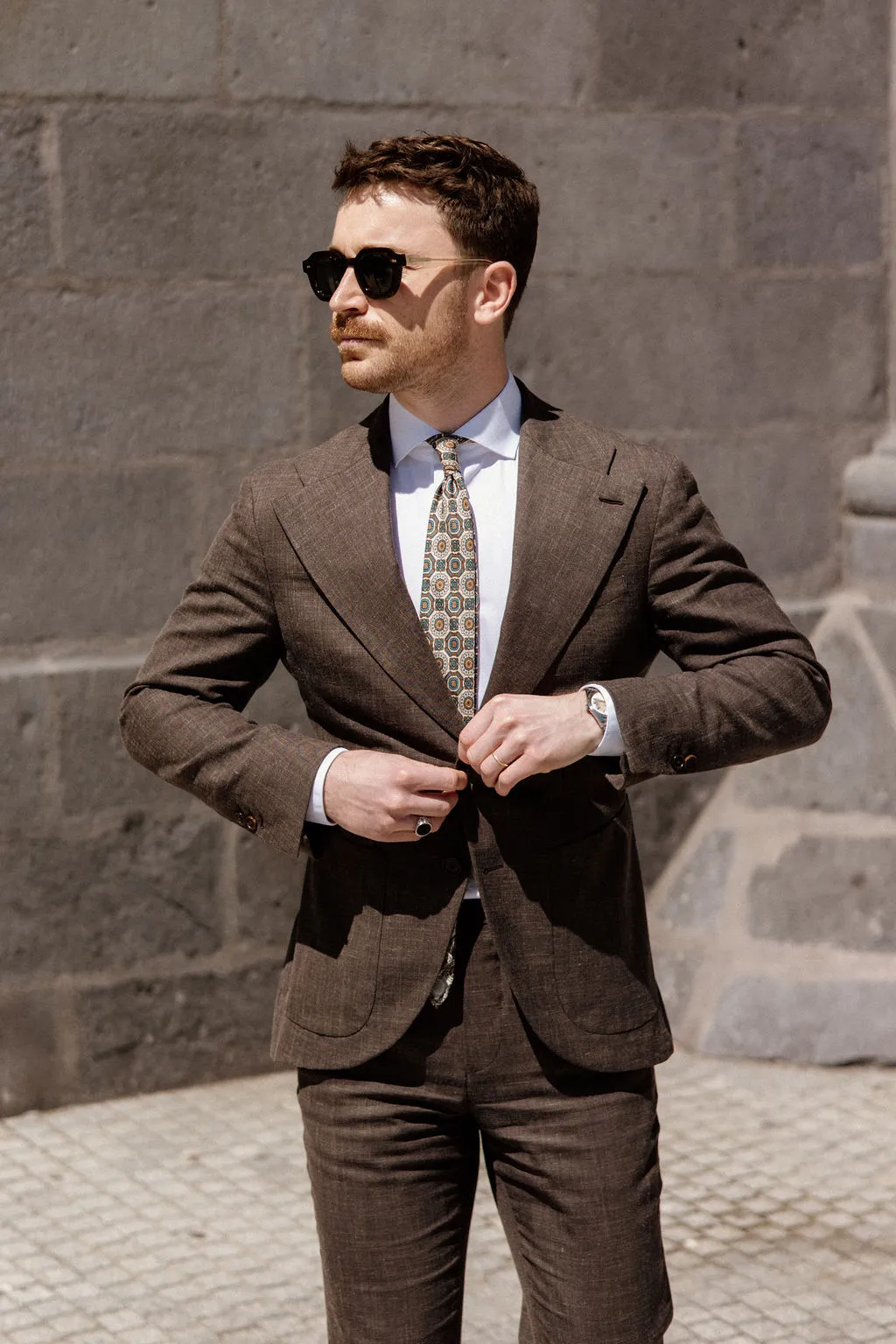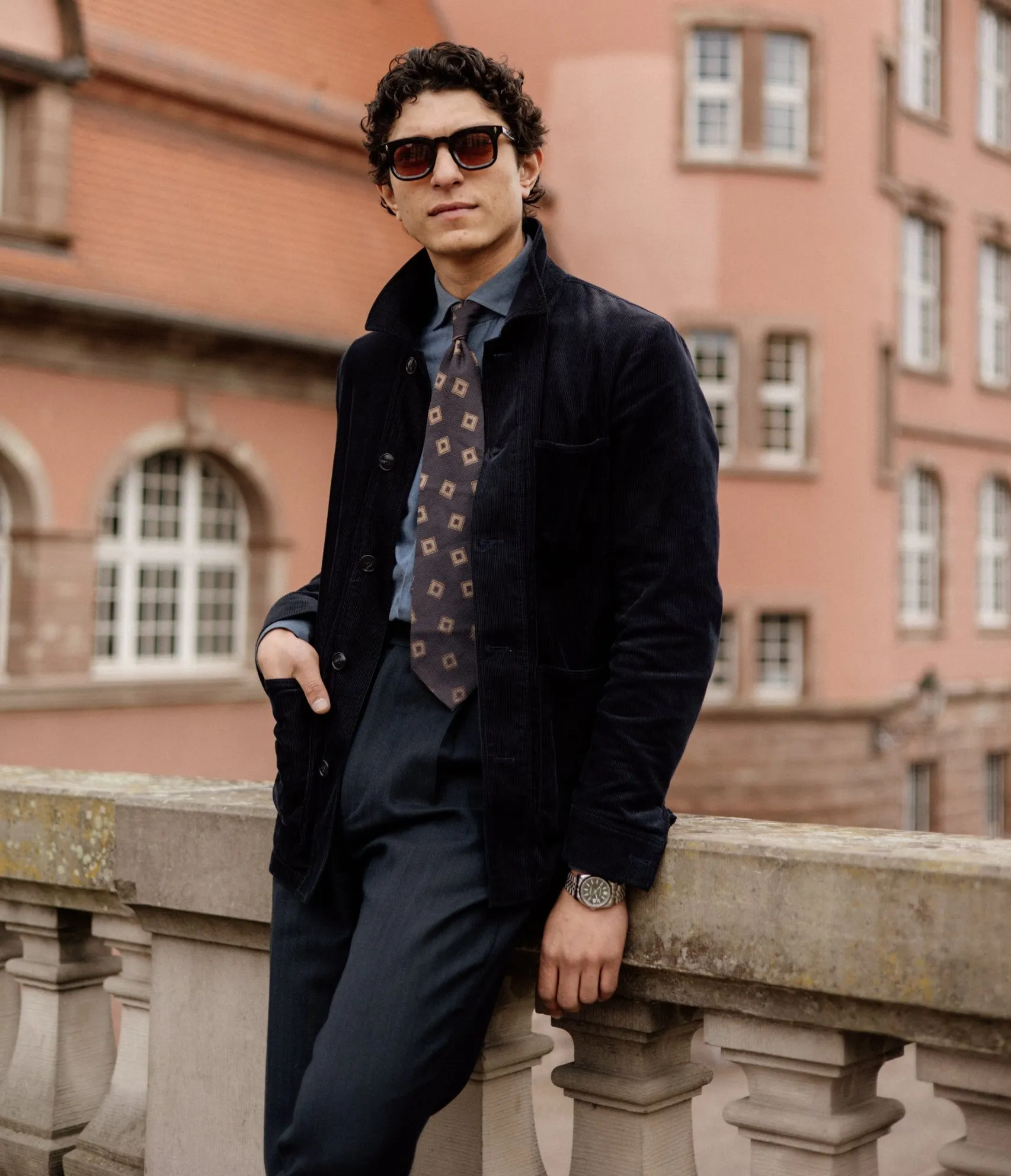
Some universal rules
There are a thousand and one rules governing the wearing of tailored suits, depending on the school (English, Italian or American). We’ll give you the broad outlines that apply to all of them.
Firstly, when you’re standing up, the jacket should be worn buttoned up (to emphasize the bend and cut). Never close the second button (it’s a cultural rule, but also because it looks ugly). When seated, unbutton your jacket (otherwise it’ll make too many unsightly folds and you’ll be uncomfortably seated). Ideally, you should button your jacket just before standing up, so that the cut of the jacket is always in evidence.
Overall length
A formal jacket should be finger-length, with the arms at your sides. There’s a clear difference between this and a casual jacket, which rises a little higher.
However, this also depends on your morphology: a slender person will wear a slightly longer jacket to elongate the bust, while shorter people will tend to wear a slightly shorter jacket to elongate the legs and slim the silhouette.
Make sure they’re aligned with the bone that joins them just before the beginning of the arm – the acromion. When you press on the shoulder seam of a jacket, you should fall directly on this bone, not sink into it. Don’t wear jackets with wider shoulders or too much padding to make them look bigger – they’ll stick in terms of proportion. This was the famous powersuit fashion of the 90s. If you go too small, your movements will be impeded and you’ll look like you’ve got a huge head.
Tightness
The most common fashion faux pas? A suit that’s too big. But with a jacket that’s too small, you’ll end up with creases and a taut silhouette. Always check that there’s only a slight tension at the side when you close the first button of the jacket. With the right size, you can put a fist between it and your torso. To find out more, we tell you all about suit assembly.
Sleeve length
First and foremost, pay attention to sleeve length. If you’re wearing a shirt sleeve, leave it about 1cm longer than the sleeve, for the classic reminder of color. Pay close attention to their width: they should fit your arms. They should be neither too wide nor too tight. Too wide and you’ll have floating kimono sleeves, and too tight and you’ll have very small arms as well as being uncomfortable and cramped.
The collar
The collar should sit on the nape of the neck, with no empty space when wearing a shirt. The two collars should lie one on top of the other: 2 cm of the shirt collar should be visible.
If the jacket completely covers the shirt collar at the nape of the neck, you’ve either fitted it wrongly or the jacket is badly cut. In my own experience, I’ve had to have the collar of some of my jackets altered because of this.
Waist width
Same problem: it’s pretty easy to tighten it, and more complicated to widen it because the amount of fabric left is unpredictable.
Fork length
Determines the waist level: low, medium or high, impossible to modify beyond plus or minus 1 cm. Take into account the length of the fork to correctly estimate the size.
Leg length and width
It’s very easy to tighten and shorten them, more complicated to widen if there’s not enough fabric. So be careful when you first try them on.
To conclude this technical section, I’d say that overall, you need to respect your morphology. If you’re a big man, opt for a suit that’s not too slim-fitting, with lapels at least 8 cm wide (anything less is no longer consistent with your morphology, and you’ll notice it in the eyes). Take the opportunity to do the same with your ties (8 cm wide) and choose collars that match them (no small collars that will make your face look bigger). For a standard physique, you have more freedom, but I’d advise you to align everything at 8 cm for consistency and peace of mind. If you’re thinner, opt for lapels between 6 and 8 cm and adjust your collars (thinner) and ties accordingly (you can easily tolerate a 1 cm gap for ties).
Ultimately, it’s a purely mathematical logic of proportions that governs the wearing of a suit. Let’s turn now to the cultural aspect of wearing a suit. This is dictated by a number of historical rules that have shaped it throughout the history of the contemporary gentleman.
How to wear a 2-piece suit
For a tailored 2-piece suit, never close the bottom button (this rule is the best-known of all, and the easiest to apply, but that doesn’t mean we can’t come across a whole host of inappropriate buttoning from time to time). In the business world, it only comes in gray or navy. It’s worth noting that if you wear it too often as a mismatch (after a few years), the hue will be different between your pants and your jacket.
How to wear a double-breasted suit
When it comes to wearing a double-breasted suit, you can either close the middle button or the bottom button, but never both.
Contrary to popular belief, anyone can wear a double-breasted jacket, except those with really wide hips, which the buttoning will emphasize. It all depends on the cut of the jacket.
It can be really interesting for small sizes if you wear jackets by closing only the bottom button. The lapel will then cross the jacket, creating a beautiful vertical line that will elongate your torso. For larger sizes, buttoning the middle button will break the vertical line, shortening your torso and thus rebalancing your silhouette.

How to wear a 3-piece suit
The size of a well-made jacket should coincide exactly with the size of the pants. Traditionally, the front of the jacket is made of the same material as the suit, while the back uses the same material as the sleeve lining. Of course, you don’t fasten the last button on either the jacket or the suit.
Now you know all about the technical and cultural rules governing the wearing of suits. Of course, these points and tips must be adapted to your personal requirements. For some, it’s enough to have a beautiful shoulder line and a nice fall, but for others, it’s the whole machine that needs to be perfectly oiled as they see fit.


